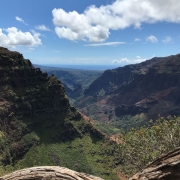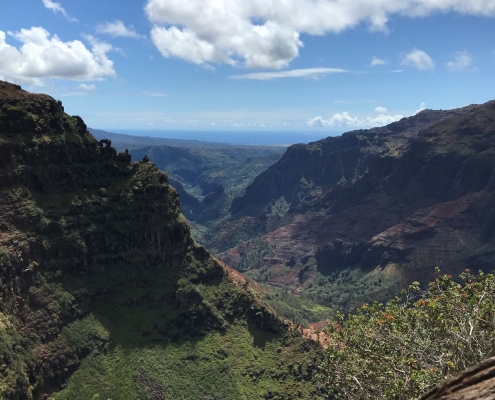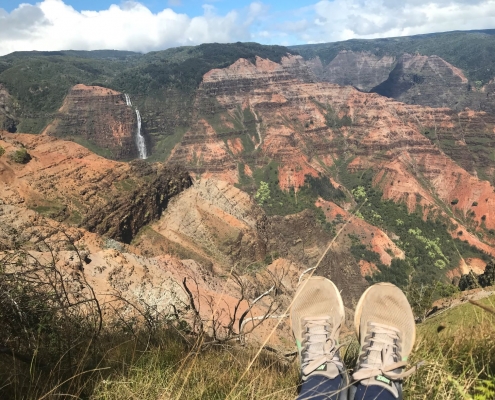Still Thursday, March 12, 2020
Friends,
We are in the LAX airport now, sending an update from earlier today, our last day on Kauai.
—-
As I write, we are headed down a 30-mile winding road from Kokee State Park, past viewpoints that provide stunning views of the Waimea Canyon, which has been called the Grand Canyon of Hawaii. This is one of the wettest spots on earth, averaging 440 inches of rain per year (and this year has been the wettest in the past 23 years). Thus, the red and green colors on the canyon walls are quite vivid – especially if you’re lucky to catch them on a sunny day, as we were. In the midst of the canyon was the Waipo’o waterfall, which had twin streams of water that fell in two tiers down the canyon wall. We hiked the canyon trail, which was a four-mile out-and-back walk that took us to the edge of the canyon (no guard rails here!) where we were able to look all the way to the ocean and see helicopters below us giving tours of the canyon. We even saw a couple of wild goats far below walking along the edges of the canyon walls. After a while, the canyon trail plunged down along highly eroded surfaces with small pieces of gravel and dirt skittering under our shoes. Although there was a promise of a waterfall view farther down, I was relieved when we agreed to turn around before the very end of the trail, as my stomach was a bit unsettled by the dramatic drop-offs. Those are some steep and slippery slopes! The best views to be had, honestly, were from the lookout spots on the road – we crawled over the guard rail and down a few steps in some rare grass to sit against the sloping canyon wall for a picnic lunch with the best view ever (photo attached). Sounds of bleating mountain goats and clucking hens added to the charm.
We decided to head down to sea level for the afternoon, where Dave enjoyed an ice cream sundae from Lappert’s, a local ice cream chain and supposedly the best ice cream in the world (which it was not – Dave is still on the lookout for the best). Meanwhile, I settled my stomach with a 5-mile run down a residential road cut into red rock and lined with horses and chickens that curiously wandered out to see me before scattering in the shade of monkeypod trees.
Back in our cabin, we enjoyed a last dinner in Kauai of everything that was left in our food bag – hummus, guacamole, crumbling cornbread, a can of beef stew, and a kale Caesar salad. The last of the sweet Hawaiian bread, which had grown stale, we threw to the four or five green-red-and-white roosters and multiple brown hens that gathered quickly outside our door, running from all directions to partake in the feast. Both mornings the birds had woken us up with rooster crows and egg cackles so loud and close outside our door we felt we were inside a hen house. Clearly, many visitors before us had also fed these birds, encouraging their extremely close proximity to the cabins.
Before leaving, we noticed signs alongside the road with a native Hawaiian name and a symbol. We had noticed these signs all over the island, and after some research (and disproving a few working theories about them) we discovered that they demarcated ancient Hawaiian zones all over Kauai. The symbol that we saw most often on the signs was a ring pounder, which was used as a tool by the natives.
During our last afternoon on Kauai, we spent some time at a shop where shell jewelry, created by native inhabitants of the (privately owned) island of Niihau, is sold. On the small and arid island of Niihu, which is within sight of Kauai, live roughly 150 native islanders, who consider themselves not Hawaiian but Niihauan. They live largely a subsistence lifestyle, and some of them continue an ancient tradition of creating shell “leis” from tiny, hard-to-find shells (much smaller than the nail on your pinkie finger) that wash up on the beaches of the island. Evidently it can take hours of sifting through the sand to find a single usable shell; a necklace can take over a year to make, given how hard it is to find the shells and how easily some of them break when threaded onto the necklace. The tradition of making leis from shells on the island of Niihau began because the island is so arid (with basically zero rainfall) so the flowers that you see on other islands do not bloom there, and thus no flower leis are possible. The intricate patterns of shells on the leis are designed to look like specific flowers that grow on Kauai and the other islands. The artistry involved is pretty amazing. We learned that the youngest person making these shell leis is 40 years old, and that the younger generation who grew up on the island are preferring to go to Kauai to get jobs or an education. This, combined with the fact that fewer and fewer of the shells used are washing up on the beaches due to global warming mean that the shell leis are a dying art form.
Speaking of leis, we grabbed two plumeria leis at the airport and are wearing them on the plane, so we are encircled with the scent of Hawaii as we depart.
We hope to send one more email with wrap-up thoughts about the trip after we get home.
Erin & Dave






